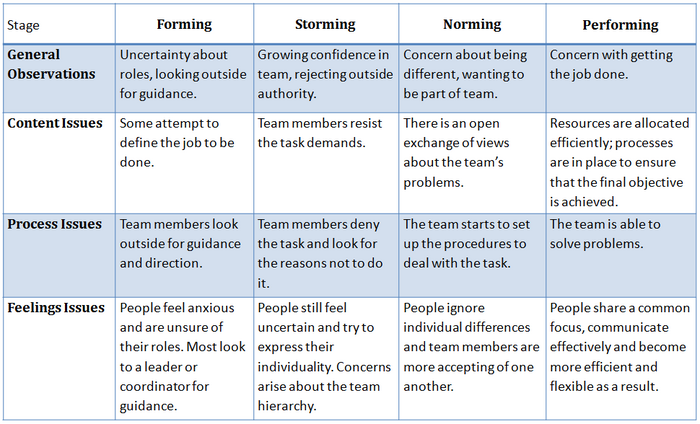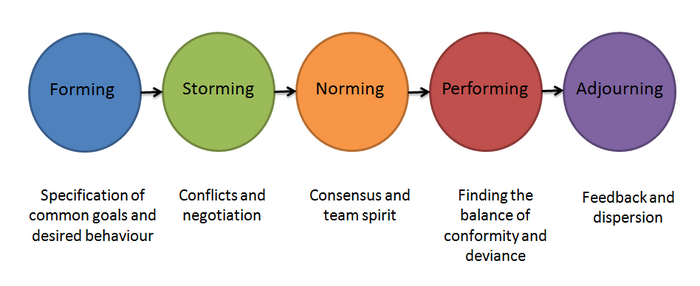Four Stages of Team Development
Self-managed work teams need considerable time to show up its real aptitudes. What a group is capable of achieving depends in part on its stage of development. The team’s effectiveness can be improved if its members are committed to evaluate their work and receive feedback. However, the most important aspect is that every team member understands their development as a team.
Although every group’s development over time is unique, researchers have identified some stages of team development that many groups seem to pass through. The most famous model is the Four Stages of Team Development, developed by the psychology professor Bruce Tuckman in 1965. Tuckman proposed that all teams start somehow unproductive when they are first formed, and then they grow into a self-sufficient unit.
Although there have been other written variations from many authors, Tuckman’s stages of development – Forming, Storming, Norming and Performing – are a helpful technique to recognize the team’s behaviour and feelings during the process. Identifying and understanding why changes occur is a key component of the self-evaluation process. This can help the team reach the state of high-performance.
Contents |
Introduction to the Model
Forming
Stage 1: Immature group
- Feelings
- Process
- Content
The principal characteristics of the Forming stage are:
- Confusion: they haven't fully understood what work the team will do
- Uncertainty
- Assessing situation
- Testing ground rules: people start to work together
- Feeling out others: they make an effort to get to know their new colleagues
- Defining goals
- Getting acquainted
- Establishing rules
Storming
Stage 2: Fractional group
- Feelings
- Process
- Content
Characteristics of the Storming stage are:
- Disagreement over priorities: members question the worth of the team's goal and they may resist taking on tasks
- Struggle for leadership: team members may jockey for position as their roles are clarified
- Tension: members who stick with the task at hand may experience stress
- Hostility: conflict between team members' natural working styles
- Clique formation
Norming
Stage 3: Sharing group
- Feelings
- Process
- Content
The characteristics of this stage are:
- Consensus: people develop a stronger commitment to the team goal
- Leadership accepted: the leader’s authority is respected
- Trust established: team members know one-another better, they may socialize together, and they are able to ask each other for help and provide constructive feedback
- Standards set
- New stable roles
- Co-operation
Performing
Stage 4: Effective group
- Feelings
- Process
- Content
The principal characteristics are:
- Successful performance: hard work leads, without friction, to the achievement of the team's goal
- Flexible, task roles
- Openness
- Helpfulness
- Delusion, disillusion and acceptance
Further Development
While working on a high-performing team may be a truly pleasurable and growthful experience, it is not the end of team development. There is still a need for the team to focus on both process and product, setting new goals as appropriate. Changes, such as members coming or going or large-scale changes in the external environment, can lead a team to cycle back to an earlier stage. If these changes - and their resulting behaviours - are recognized and addressed directly, teams may successfully remain in the Performing stage indefinitely.
Some teams do come to an end, when their work is completed or when the organization needs change. While not part of Tuckman’s original model, it is important for any team to pay attention to the end or termination process.
Adjourning
Stage 5: Disbanding group
In 1977, Tuckman, jointly with Mary Ann Jensen, added a fifth stage to the 4 stages: Adjourning, that involves the process of unforming the group, letting go of the group structure and moving on. Some authors describe this stage as “Deforming and Mourning”, recognizing the sense of loss sometimes felt by team members. Adjourning involves dissolution. It entails the termination of roles, the completion of tasks and reduction of dependency.
- Feelings
Team members may feel a variety of concerns about the team’s impending dissolution. They may be feeling some anxiety because of uncertainty about their individual role or future responsibilities. They may feel sadness or a sense of loss about the changes coming to their team relationships. And at the same time, team members may feel a sense of deep satisfaction at the accomplishments of the team. Individual members might feel all of these things at the same time, or may cycle through feelings of loss followed by feelings of satisfaction. Given these conflicting feelings, individual and team morale may rise or fall throughout the ending stage. It is highly likely that at any given moment individuals on the team will be experiencing different emotions about the team's ending.
- Process
During the Ending Stage, some team members may become less focussed on the team's tasks and their productivity may drop. Alternatively, some team members may find focussing on the task at hand is an effective response to their sadness or sense of loss. Their task productivity may increase.
- Content
The team needs to acknowledge the upcoming transition and the variety of ways that individuals and the team may be feeling about the team’s impending dissolution. During this stage, the team should focus on three tasks:- Completion of any deliverables and closure on any remaining team work
- Evaluation of the team’s process and product, with a particular focus on identifying "lessons learned" and passing these on to the sponsor for future teams to use
- Creating a closing celebration that acknowledges the contributions of individuals and the accomplishments of the team and that formally ends this particular team's existence.
This final stage involves the disengagement of relationships between team members and a short period of recognition for the team’s achievements. Sometimes, concluding the operations of a team is disturbing for members, especially if they have worked together for long periods of time. The process can be stressful, particularly when the dissolution is unplanned.
This stage is characterized by:
- Disengagement
- Anxiety about separation and ending
- Positive feeling towards leader
- Sadness
- Self-evaluation

